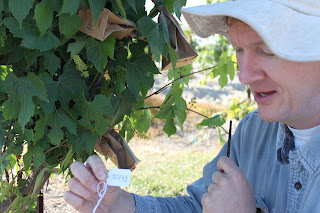Some wild grapevine species have unique nematode resistance mechanisms, and are thus used as parents in rootstock breeding. Cousin’s goal is to incorporate as many different forms of resistance as possible into new rootstocks, so some advanced selections are complex hybrids of several species. Wild grapevines, and their hybrids, are dioecious; invididual vines bear clusters of either male or female flowers. Dioecious vines are relatively easy to cross as the flowers do not have to be emasculated; to prevent unwanted crosses, he simply encloses female flower clusters in paper bags prior to bloom.
As bloom approaches, he periodically he taps on the bags, listening for the rattle of detached petals that signals the blossoms are ready to be pollinated. Properly prepared, pollen, which Cousins prepares by grinding flowers in a coffee mill, can be stored for a relatively long time, facilitating crosses between vines that might not flower at the same time. To pollinate, the bags are removed, the appropriate pollen is slathered on with paint brush, and the cluster is labeled, and recovered with the bag. Cousins will return in the summer, to extract the seeds from the fruit. Seedlings will then be screened for nematode resistance, and the best selections may eventually end up returning to Parlier, to be evaluated alongside their parents. To learn more about Dr. Cousin’s research program, and see his rootstock selection vineyard, plan to attend Grape Day at Kearney, August 18, 2011.



No comments:
Post a Comment